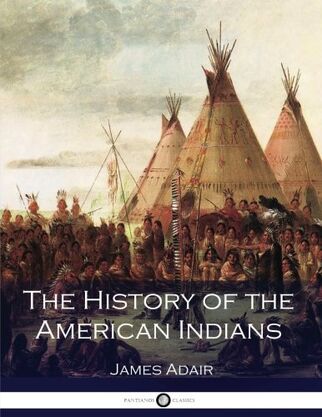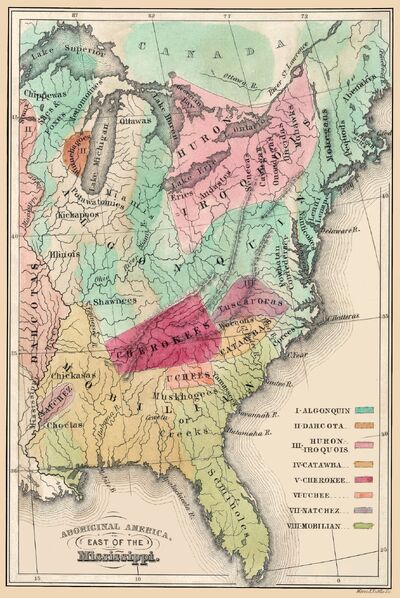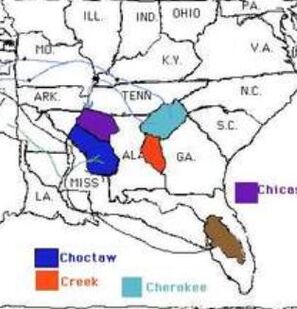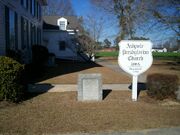
- Scotch-Irish Immigrant to America
- Early 18th Century Indian Trader
- Early Historian of Southeast America Native Tribes
Biography
James Adair was born circa 1714 in County Antrim, Northern Ireland, United Kingdom (Ulster) to Thomas Adair (c1680-c1740) and Margaret Marie Henart (c1680-c1750) and died circa 1788 Laurens County, South Carolina, United States of unspecified causes. He married Eleanor Adair (1726-1803) 1744 in South Carolina, United States.

Map of Native American Nations circa 1600.
James went from Ireland to North America and became a trader with the Native Americans of the Southeastern Woodlands. He became a noted explorer and historian.
From: The Dictionary of American Biography:
ADAIR, James, pioneer Indian trader, author, is said to have been born in County Antrim, Ireland. The dates given above are merely conjectural.
It is certain that Adair was highly educated. By 1735 he had come to America, probably entering at the port of Charleston, SC. In that year he engaged in trade with the Catawbas and Cherokees, continuing with them until 1744. He then established himself among the Chickasaws, whose villages were on the headwaters of the Yazoo, in Mississippi, where he remained for about six years. During the latter part of this period he frequently visited the Choctaws, in an effort to counteract the influence of the French and to win them to an alliance with the English. The effort was successful, but it involved him in difficulties with other traders and with James Glen, royal governor of South Carolina from 1743 to 1756, which resulted, he asserts, in his financial ruin.
In 1751 he moved to District Ninety-six (the present Laurens County), SC, and resumed trade with the Cherokees, remaining there until about the end of 1759. His activities during these years covered a wide range. He was several times called in council by Gov. Glen, with whom he could never agree and whom he heartily detested. Among the Indians he was a diplomat and a peace maker, but he was also a fighter--"a valiant warrior," says Logan; and when he could not compose their quarrels he not infrequently took sides in their wars. At various times he was engaged in conflicts with the French. In the Indian war of 1760-61 he commanded a band of Chickasaws, receiving his supplies by way of Mobile. In 1769 he visited New York City. Either then or a few years later he probably voyaged to London. Of his later life nothing authentic is recorded. He was, as the conclusion of his book amply shows, a vigorous defender of the rights of the colonies, but there appears to be no mention of him in Revolutionary annals. He is said to have been married and to have has several children and also to have died in North Carolina shortly after the close of the Revolution.
History of the American Indians
James Adair spent 30 years visiting the indians and collecting meticulous notes for his book: History of the American Indians. Originally published in London in 1775 by Loyalists supporters, partly as an effort to avert war between England and the colonies. Translated into German in 1782. Reprinted in the United States in 1930 and again in 2015. His older sons, at least, joined him in many of his travels. The book is highly valued as a eyewitness account of indian life in the Southeastern woodlands of America before the encroachment of the white man and their expulsion westwards.
- Standard Book Version - 206 pages
- Annotated book version - 600+ pages (includes much commentary from modern scholars.)
Description from Amazon Books:
James Adair was a passionate chronicler, explorer and trader who ventured through North America in an effort to discover new lands and exchange goods with the native peoples. He spent decades traversing what is now the Deep South of the United States, and was among the first white men to discover certain tribes, distinguishing between their behaviors and customs with a depth no historian had managed. Although an amateur scholar, Adair meticulously recorded his observations. As a result, this book contains both mundane and profound facts - the sum combining to form an evocative picture of peoples now lost to time. The joys of community and traditions such as dancing and ceremonies are tempered by the inter-tribal conflicts, murder and blood feuds, incipient alcoholism and increasing threat of European settlers.
Close to half of this book is dedicated to the notion that the Native American tribes are descended from the 'lost tribes of Israel'. Now discredited after anthropologists determined the original migration routes, it is thought Adair inserted these analyses in part to cater for popular demand at the time. From the mid-17th to the early-19th century, the notion that the Native Americans were directly descended from the Israelites of ancient times was a popular phenomenon. Many scholars postulate that the Book of Mormon was partly inspired by Adair's history. The rest of Adair's work however contains insights that can never be rediscovered or elaborated upon. The wars and gradual conquest of the Native American tribes by white settlers left precious little of their culture available for scrutiny by subsequent generations of historian. As such, this book remains one of the most valuable and cited primary sources on the subject.
18th Century Indian trader
Prior to 1700 traders had reached the Indian tribes on the Mississippi; i that year they were found there by the French. McCrady says that many of the early fortunes of Charleston families were built up by the Indian trade. This is more than can be said of the traders who adventured themselves into the wilderness encompassed by manifold dangers to make possible the merchants' fortunes. Augusta followed as chief mart. "It was laid out in the beginning of the year 1736, and thrives prodigiously. It is the chief place of trade with the Indians.[1]
There are several warehouses in it well furnished with goods for the Indian trade. There are five large boats which belong to different inhabitants of the town, and carry about nine thousand weight of deer skins, each; and last year about one hundred thousand weight of skins was brought from there. All the Indian traders from both provinces of South Carolina and Georgia, resort thither in the spring. In June, 1739, the traders, pack-horsemen, servants, townsmen, and others dependent upon that business, made about six hundred whites who live by the trade in the Indian nations. Each hunter is reckoned to get three hundred weight of deer skins in a year, which is a very advantageous trade to England, for the deer skins, beaver and other furs are chiefly paid for in woolen goods and iron." [2]
Dixie Land explorer
Also in his book, Adair sings great praise to this future Dixie Land as some of the potentially best farmland in North American, something that many of his descendants acted upon in the next several generations. Whenever these grandchildren moved westward, it’s timing is right on the heals of certain major political developments opening up the countryside to settlers.
“If British subjects [prior to the great rebellion] could settle West-Florida [modern day states of Alabama and Mississippi] in security, it would in a few years become very valuable to Great-Britain; and they would soon have as much profit, as they could desire, to reward their labor.”[3]
Biographical timeline

Indian tribes of Southeastern U.S. visited by James Adair. (1735-1775)
In the preface of his book James declares he lived forty years with the indians of various tribes (from 1735 to 1775) including relocating in 1744 to more closely associate with the Chickasaw Nation.
- 1735 : Move to upstate South Carolina to trade with Catawbas and Cherokee (per his book). For nine years his main occupation running a trade route with the new seaport of Charleston, South Carolina westward to the highland home of the Cherokee.
- 1740 : Encounters Christian Pribus leading the Cherokee astray, reports him to Colonial authorities.
- 1744 : Move to Chickasaw Nation in northern Mississippi at the headwaters of the Yazoo River. There marries a squaw and has children. His main trade route still seems to lie between the Eastern Chickasaw tribes in upper South Carolina and Charleston. (until 1763).
- 1744-48: King George's War, Adair leads effort to use trading to sway the Choctaw (visiting with Chief Red Shoes) from a French alliance to the English at the direction of Gov James Glen or South Carolina. Effort fails and Adair is left bankrupt and deeply in debt. Begins drafting a history to clear his name in the failed "Choctaw Revolt" and lays much of the blame on Gov Glen.[4]
- 1747 : Leads band of Chickasaw to hunt down renegade Frenchmen, Peter Shartee, believed to be hiding with the Shawano indians.
- 1750 : Mediates between SC Govt and indians during War with the Katahba.[5]
- 1750 : Escape from the Cherokee and meets with traders at Ninety-Six Settelment.[6]
- 1751 : Moves to the Ninety-Six District (upstate South Carolina) to trade again with Cherokee. His brothers come join him.
- 1759-61: Cherokee-South Carolina War.[7][8][9]
- 1760-61: French & Indian wars, commander of band of Chickasaw based out of Mobile to counteract French influence amongst the Choktaw and Cherokee. His brother Joseph Adair (1711-1788) and family leaves Lancaster County, Pennsylvania for Laurens County, South Carolina.
- 1763-Feb-10: Treaty of Paris ending French & Indian War. France cedes Louisiana Territory east of Mississippi to Great Britain opening up new trading range for James Adair. Adair dramatically changes his trading patern where he uses the seaport and river of Mobile, Alabama to travel a northerly route to the lands of the Western Chickasaw. (1763-1767)
- 1765-Oct-18: Escape from Choktaw ambush. [10]
- 1766-? : It was at Fort Alabama that Adair was imprisoned a fortnight for activity among the Indians. He managed to escape an hour before the king's boat left, which was to carry him down to Mobile to be hanged.[11]
- 1767 : Attends Chickasaw trade meeting, possibly at Mobile

Adair Map published in his book. (highlights added afterwards) Note the British colony land claims extending all the way to the Mississippi River as allowed by the 1763 Treaty of Paris
- 1767 : Retirement from active trading and appears to settle in Laurens County, South Carolina near Duncan Creek, but still continues a lot of interaction with the Chickasaw and other tribes as he is now busy writing his "essays" that would become his book.
- 1768-Jan : Adair at Fort Tombigbee when it is abandoned.
- 1768-Feb-02: Duncan Creek Land Warrant - James and Joseph both petition for "Warrants of Survey" for lands at the Waters of Duncan Creek. (SC Archives, Council Journal 34, p39)
- 1768-Feb-27: Announcement in a New York paper of the arrival of James Adair with copies of his "essays" on the indians ready for distribution. (Indicates that his book was mostly done at that time, but seemingly contridicts his ability to file Land Warrent earlier in the month at Duncan Creek.)
- 1768-May-01 : "Raid of the Great Mortar" story takes place after Adair returns to South Carolina.
- 1768-Dec-07: Warrant Extension - James and Joseph both petition to prolong warrants. (SC Archives, Council Journal 34, p236)
- 1769: Visit to New York City.
- 1770: Land warrant granted to brother Joseph for 250 acres where the Duncan Creek Church now stands.
- 1772-Jun-04/08 : Adair in Cork, Ireland to recover his manuscript stolen from London.
- 1773-Jun-03 : 200 acres surveyed in SC for Adair.
- 1774-Mar-25 : Benjamin Franklin (1706-1790) writes letter of recommendation for Adair's book to be published.
- 1774-Oct-28 : Adair witnessed a deed from Creek leaders to Jonathan Bryan of Georgia for half of the Florida panhandle. He probated the deed in Granville County, South Carolina.
- 1775 : Book is published in London.
- 1779: Colonel Williams Memorial Petition - signatory.
- 1784-1790: Death is sometime between 24-Feb-1784 (date of deed to John Jones, blacksmith) and 12-Feb-1796 (date of deed of Eleanor, widow of James Adair, releasing her dower). See Below
Modern Records Supporting Adair
- Big Chief Rabbi: Why Cherokees Could be Jewish - Mr Yates, who is of Cherokee descent himself, runs a Colorado-based, for-profit website called dnaconsultants.com, which lets people track down their DNA profiles. He sites abundant DNA markers found in the Cherokee line. (Published in The Jewish Chronicle 30-Sep-2016).
Marriage and family
James Adair was a Scotch-Irish immigrant to America that settled in the Chickasaw Indian Territory of upstate Mississippi near the headwaters of the Yazoo River in 1744. Some time after that he married Eleanor of the Chickasaw Nation. Eleanor was born in the Chickasaw Nation about 1726. She was a member of the Panther clan. James died probably in Laurens County, South Carolina, after 25 Feb 1784 and before 12 Feb 1796. Eleanor died probably in Laurens County after 3 Jan 1803.
In his book, James Adair writes at great length about the warrior skills and customs of the Chickasaw. These men were important allies of the British in the ongoing French and Indian Wars of early America. Eleanor's brothers, uncles, cousins, etc, were most like part of this group (and may even have played a key role in arranging his marriage?)
From the accounts of Adair and other traders who were able to reach the consolidated villages inside the embattled settlement of Chokkilissa', we see that women did most of the work connected with running the household. Archaeological evidence shows us what they used and when (within a range of years) in some cases. Even before the mid-eighteenth century, women had an assortment of European tools that made the work less burdensome and time-consuming. Purdue University historian Wendy St. Jean wrote that some Chickasaw women married traders in part or in whole to obtain these convenience items for themselves and their kin.
With metals pots, they did not have to spend so much time fashioning pottery for cooking. With cloth, they did not have to spend hours processing and brain-tanning deerskin for clothes. With horses and plows, they could work a field or garden in a fraction of the time that they formerly spent breaking up the soil with hand tools.
Children
| Name | Birth | Death | Joined with |
| Joseph Adair (1745-1820) | 1750 Chickasaw Nation | 5 February 1804 Duncan Creek, Laurens County, South Carolina | Sarah Lowe (1750-1844) |
| James Adair (1748-1818) | 1750 Chickasaw Nation | 18 August 1818 Laurens County, South Carolina | Hannah Unknown (1750-1826) |
| John Adair (1754-1815) | 1754 Chickasaw Nation | November 1815 Oconee County, South Carolina | Nancy Ga-Ho-Ga Lightfoot (1760-1789) Jane Kilgore (1773-1815) |
| Edward Adair (1756-1800) | 1756 Chickasaw Nation | November 1800 Oconee County, South Carolina | Elizabeth Martin (c1760-1816) |
| Hannah Adair (1759-1810) | 1759 Chickasaw Nation | 1810 Oconee County, South Carolina | John Jones (c1755-) |
| Laferty Adair (c1760-) | 1760 Chickasaw Nation | 1810 Oconee County, South Carolina | |
James and Eleanor were the parents of the following children:
- James Adair, Jr. was born in the Chickasaw Nation about 1748. He married Hannah probably in Laurens County about 1772. Hannah was born probably in Laurens County on 28 Sep 1750. James died in Laurens County on 18 Aug 1818. Hannah died in Laurens County on 10 Nov 1826.
- Joseph Adair (1745-1820) was born in the Chickasaw Nation about 1750. He married Sarah probably in Laurens County about 1776. Joseph died perhaps in Laurens County after 5 Feb 1804.
- John Adair (1754-1815) was born in the Chickasaw Nation about 1754. He married first Ga-Ho-Ga of the Cherokee Nation probably in Laurens County say about 1780. Ga-Ho-Ga was born in the Cherokee Nation about 1760. Ga-Ho-Ga died perhaps in Laurens County after 7 Feb 1789. John married second Jane Kilgore probably in Laurens County about 1790. Jane was born probably in Laurens County about 1773. John died in present-day Oconee County, South Carolina, after 4 Nov 1815 and before 4 Dec 1815. Jane died perhaps in present-day Oconee County after 4 Dec 1815.
- Edward Adair (1756-1800) was born in the Chickasaw Nation about 1756. He married first Margaret in Philadelphia on 7 Apr 1784. Edward married second Elizabeth Martin of the Cherokee Nation probably in the Cherokee Nation about 1789. Elizabeth was born probably in the Cherokee Nation about 1769. Edward died probably in present-day Oconee County after 3 Nov 1800. Elizabeth died probably in the Cherokee Nation after 13 Jul 1816.
- Laferty Adair (c1760-) - based on the LDS records of St. George Utah Temple as reported by relatives in the 1870s. Further research needed.
- Hannah Adair (1759-1810) who married John Jones, which can possibly be construed but not proven from a land deed. See the notes in this database for both of these individuals for a fuller explanation. Further research needed.
Siblings
| Name | Birth | Death | Joined with |
| James Adair (1714-1796) | 1714 County Antrim, Northern Ireland, United Kingdom (Ulster) | 1788 Laurens County, South Carolina, United States | Eleanor Adair (1726-1803) |
| Joseph Adair (1711-1788) | 1711 County Antrim, Northern Ireland, United Kingdom | 1788 Laurens County, South Carolina, United States | Sarah Laferty (1715-1767) Susanna Murdough (1723-1800) |
| William Adair (c1718-1812) | 1718 County Antrim, Northern Ireland, United Kingdom | 1812 Mercer County, Kentucky, United States | Mary Moore (1729-1797) |
Residences
Notable descendants
- William Penn Adair (1830-1880) - Cherokee tribal leader, civil war colonel, and namesake of Will Rogers
- George Washington Adair (1806-1862) - "Chief George W Adair" - Cherokee tribal leader and signatory of the 1835 Treaty of New Echota (Trail of Tears).
- James Richey (1821-1890) - Mormon missionary that led a major group of the Adair family to become the basis of the Dixie Saints group of the LDS Church.
- Benjamin Richey (1823-1849) - Veteran of Mormon Battalion
Vital records
Research notes
Death Date (1784-1790)
James Adair died sometime between 24-Feb-1784 (his signature on date of deed to John Jones, blacksmith) and Aug-1790, when the 1st US Federal Census is tabulated. There are two James Adairs listed on that census that we can directly links to someone else. Also on 12-Feb-1796 (date of deed of Eleanor, widow of James Adair, releasing her dower).
Historical figures cited
A number of historical figures / fellow traders / are cited in Adair's book with whom he had interaction. Their history adds context to Adair's life.
- George Galphin (pg 162) - He kept the Creek (Mushogke) nation neutral during the Revolutionary War
- Lachlan McGillivray (pg 162) - indian trader / plantation owner
- James Glen - Long serving colonial governor of South Carolina (1738-56) who dispatched Adair on mission to pacify the Choctaw, but then abandoned him afterwards.
Erroneous records
Ashpole Church memorial

Located in front of Ashpole Presbyterian Church in Rowland, North Carolina is a large memorial stone tribute to James Robert Adair, listing his exploits as pioneer physician, patriot of the revolutionary war and indian historian. No information on who put this stone here or why. FindAGrave attempts to link him to immigrant Thomas Adair, but GENI.com gives many reasons to thoroughly dispute this association. This spot is most likely the final grave of Robert Adair (1709-1783), no relation to our James Adair, but frequently confused with him.
Footnotes (including sources)
References
- ^ An Impartial Inquiry, London, 1741, also in Ga. Hist. Coll. I, 153 et seq."[Samuel Cole Williams, "Adair's History of the American Indians," (New York, NY: Promontory Press, 1930), p. 394]
- ^ An Impartial Inquiry, London, 1741, also in Ga. Hist. Coll. I, 153 et seq."[Samuel Cole Williams, "Adair's History of the American Indians," (New York, NY: Promontory Press, 1930), p. 394]
- ^ HOAI, pg 162
- ^ James Adair - Encyclopedia of Alabama.
- ^ History of the American Indians pg 66
- ^ History of the American Indians pg 80
- ^ James Adair - Encyclopedia of Alabama.
- ^ Cherokee War of 1759-61 - Encyclopedia of South Carolina
- ^ History of the American Indians by James Adair, pp 113-115
- ^ H.O.A.I. pg 132-133
- ^ Colonial Mobile; an historical study largely from original sources, of the Alabama-Tombigbee basin and the old South West, from the discovery of the Spiritu Santo in 1519 until the demolition of Fort Charlotte in 1821" pg 190
See also
- James Adair
- James Adair in the Ninety-Six District
- James Adair (1714-1796)/list of notable descendants
- Adair in Robeson County, North Carolina
- Adair in Laurens County, South Carolina
- Adair in County Antrim
- Adair's History of American Indians - Mormon Wikia analysis of the James Adair history book.
- wikipedia:en:James Adair (historian) - Wikipedia
- James Adair, Indian Trader - GENI
- Dr James Robert Adair at Find A Grave #65263142
- Who Was Who in America, Historical Volume, 1607-1896. Chicago: Marquis Who's Who, 1967.
- The History of the American Indians (Internet Archive)
- James Adair Profile and Videos - Chickasaw.TV - Modern day historians discuss the merits and accomplishments of James Adair, his book and his adventures with the Chickasaw.
- James Adair and Chickasaws, Part II - The Way of the Warriors (2004) - Chickasaw.net.
- Chickasaw Wife and Family of James Adair, Author of the History of the American Indians. - unpublished work by Shawn Potter Aug 2015. Shawn and his wife Lois are the authors of a book to be published sometime in the future entitiled. The book uses extensive historical documentation and modern DNA analysis to assemble his family history.
- "Early Adairs of Laurens County, South Carolina," compiled by Mildred Brownlee, 1990, copy at the Laurens County Library; Source Records: Wills; Intestate Estates; Deeds; Court Records; Cemetery Inscriptions. Some dates of birth and death obtained from Lineage Charts. Dates of birth and death subject to correction. Spelling of names subject to correction."
- Colonial Mobile: An Historical Study, largely from Original Sources, of the Alabama-Tombigbee Basin from the Discovery of Mobile Bay in 1519 until the Demolition of Fort Charlotte in 1821 - by Peter J Hamilton, 1897, Houghton, Mifflin and Company.
- Chief Red Shoes - Leader of the British faction of Choctaw tribe in their civil war of 1747-1750. This event left Adair bankrupt and began his literary efforts.
- James Adair History - Adair-Holland Family History website: Adair-Holland.com
- James Adair - AlabamaPioneers.com
| This page uses content from the English language Wikipedia. The original content was at James Adair (historian). The list of authors can be seen in the page history. As with this Familypedia wiki, the content of Wikipedia is available under the Creative Commons License. |
